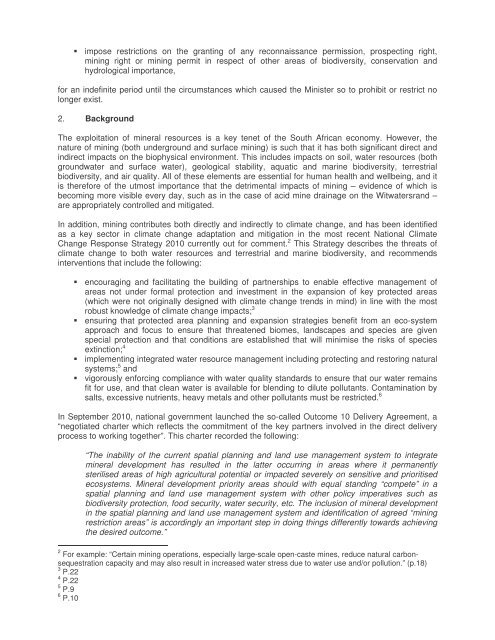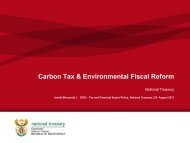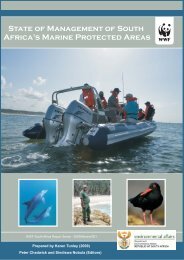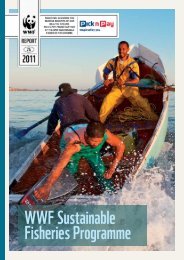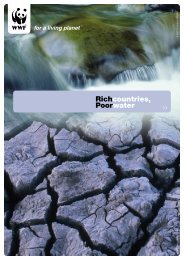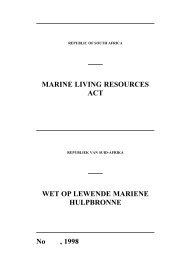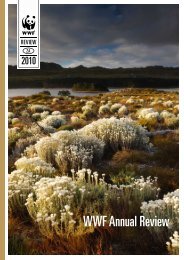CER Letter to Minister Shabangu re MPRDA s49 - 1 Feb 2011
CER Letter to Minister Shabangu re MPRDA s49 - 1 Feb 2011
CER Letter to Minister Shabangu re MPRDA s49 - 1 Feb 2011
Create successful ePaper yourself
Turn your PDF publications into a flip-book with our unique Google optimized e-Paper software.
impose <strong>re</strong>strictions on the granting of any <strong>re</strong>connaissance permission, prospecting right,<br />
mining right or mining permit in <strong>re</strong>spect of other a<strong>re</strong>as of biodiversity, conservation and<br />
hydrological importance,<br />
for an indefinite period until the circumstances which caused the <strong>Minister</strong> so <strong>to</strong> prohibit or <strong>re</strong>strict no<br />
longer exist.<br />
2. Background<br />
The exploitation of mineral <strong>re</strong>sources is a key tenet of the South African economy. However, the<br />
natu<strong>re</strong> of mining (both underground and surface mining) is such that it has both significant di<strong>re</strong>ct and<br />
indi<strong>re</strong>ct impacts on the biophysical environment. This includes impacts on soil, water <strong>re</strong>sources (both<br />
groundwater and surface water), geological stability, aquatic and marine biodiversity, ter<strong>re</strong>strial<br />
biodiversity, and air quality. All of these elements a<strong>re</strong> essential for human health and wellbeing, and it<br />
is the<strong>re</strong>fo<strong>re</strong> of the utmost importance that the detrimental impacts of mining – evidence of which is<br />
becoming mo<strong>re</strong> visible every day, such as in the case of acid mine drainage on the Witwatersrand –<br />
a<strong>re</strong> appropriately controlled and mitigated.<br />
In addition, mining contributes both di<strong>re</strong>ctly and indi<strong>re</strong>ctly <strong>to</strong> climate change, and has been identified<br />
as a key sec<strong>to</strong>r in climate change adaptation and mitigation in the most <strong>re</strong>cent National Climate<br />
Change Response Strategy 2010 cur<strong>re</strong>ntly out for comment. 2 This Strategy describes the th<strong>re</strong>ats of<br />
climate change <strong>to</strong> both water <strong>re</strong>sources and ter<strong>re</strong>strial and marine biodiversity, and <strong>re</strong>commends<br />
interventions that include the following:<br />
encouraging and facilitating the building of partnerships <strong>to</strong> enable effective management of<br />
a<strong>re</strong>as not under formal protection and investment in the expansion of key protected a<strong>re</strong>as<br />
(which we<strong>re</strong> not originally designed with climate change t<strong>re</strong>nds in mind) in line with the most<br />
robust knowledge of climate change impacts; 3<br />
ensuring that protected a<strong>re</strong>a planning and expansion strategies benefit from an eco-system<br />
approach and focus <strong>to</strong> ensu<strong>re</strong> that th<strong>re</strong>atened biomes, landscapes and species a<strong>re</strong> given<br />
special protection and that conditions a<strong>re</strong> established that will minimise the risks of species<br />
extinction; 4<br />
implementing integrated water <strong>re</strong>source management including protecting and <strong>re</strong>s<strong>to</strong>ring natural<br />
systems; 5 and<br />
vigorously enforcing compliance with water quality standards <strong>to</strong> ensu<strong>re</strong> that our water <strong>re</strong>mains<br />
fit for use, and that clean water is available for blending <strong>to</strong> dilute pollutants. Contamination by<br />
salts, excessive nutrients, heavy metals and other pollutants must be <strong>re</strong>stricted. 6<br />
In September 2010, national government launched the so-called Outcome 10 Delivery Ag<strong>re</strong>ement, a<br />
“negotiated charter which <strong>re</strong>flects the commitment of the key partners involved in the di<strong>re</strong>ct delivery<br />
process <strong>to</strong> working <strong>to</strong>gether”. This charter <strong>re</strong>corded the following:<br />
“The inability of the cur<strong>re</strong>nt spatial planning and land use management system <strong>to</strong> integrate<br />
mineral development has <strong>re</strong>sulted in the latter occurring in a<strong>re</strong>as whe<strong>re</strong> it permanently<br />
sterilised a<strong>re</strong>as of high agricultural potential or impacted seve<strong>re</strong>ly on sensitive and prioritised<br />
ecosystems. Mineral development priority a<strong>re</strong>as should with equal standing “compete” in a<br />
spatial planning and land use management system with other policy imperatives such as<br />
biodiversity protection, food security, water security, etc. The inclusion of mineral development<br />
in the spatial planning and land use management system and identification of ag<strong>re</strong>ed “mining<br />
<strong>re</strong>striction a<strong>re</strong>as” is accordingly an important step in doing things diffe<strong>re</strong>ntly <strong>to</strong>wards achieving<br />
the desi<strong>re</strong>d outcome.”<br />
2 For example: “Certain mining operations, especially large-scale open-caste mines, <strong>re</strong>duce natural carbonsequestration<br />
capacity and may also <strong>re</strong>sult in inc<strong>re</strong>ased water st<strong>re</strong>ss due <strong>to</strong> water use and/or pollution.” (p.18)<br />
3 P.22<br />
4 P.22<br />
5 P.9<br />
6 P.10


